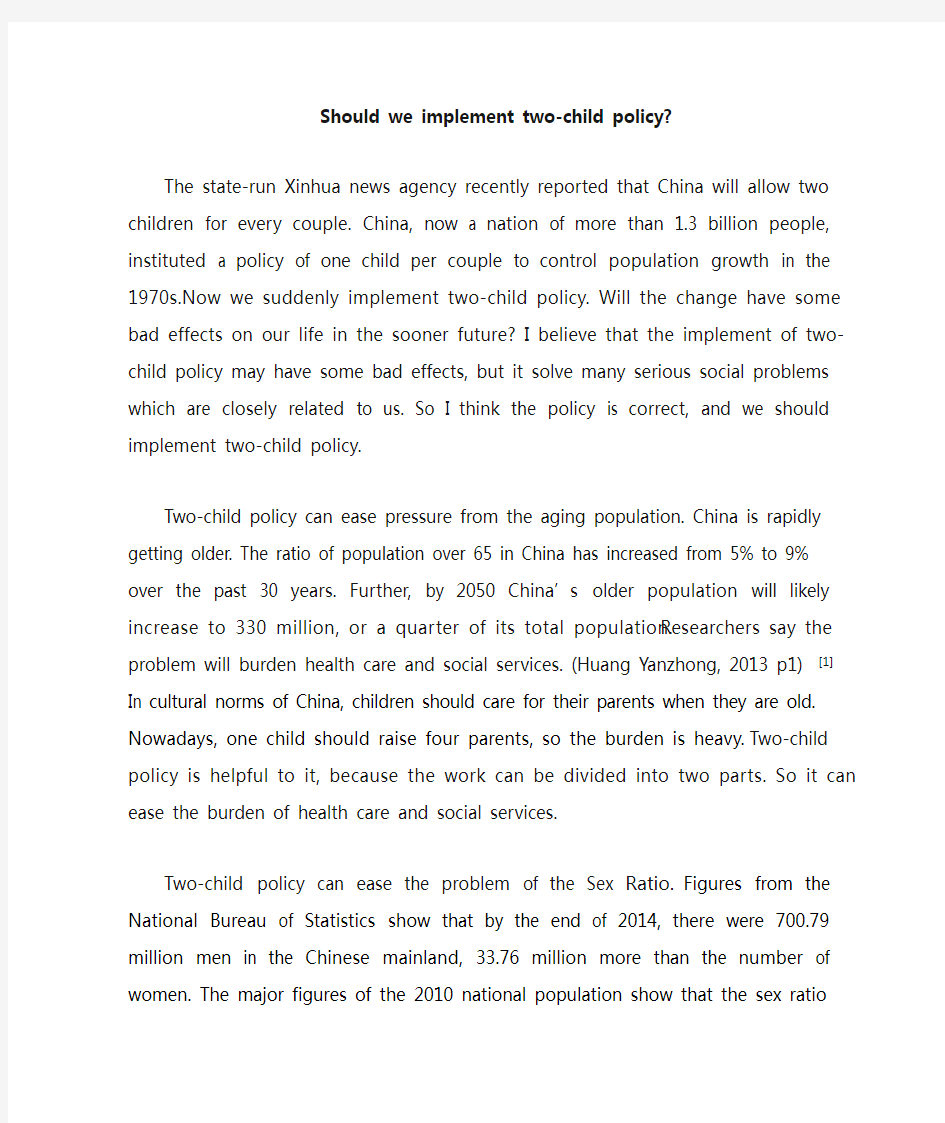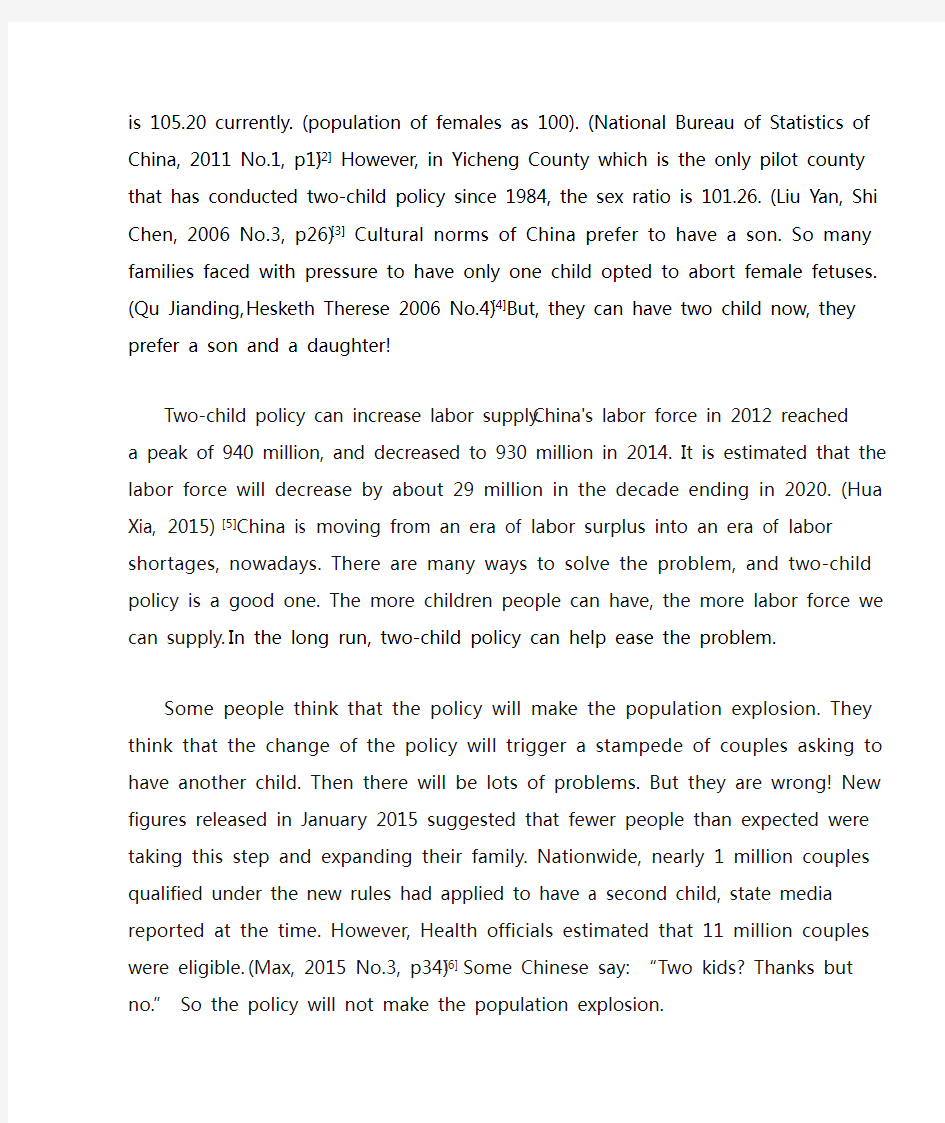two-child_policy


Should we implement two-child policy?
The state-run Xinhua news agency recently reported thatChina will allow two children for every couple. China, now a nation of more than 1.3 billion people, instituted a policy of one child per couple to control population growth in the 1970s.Now we suddenly implement two-child policy. Willthe change have some badeffects on our life in the sooner future? I believe that the implement of two-child policy may have some bad effects, but it solve many serious social problems which are closely related to us. So I think the policy is correct, and we should implement two-child policy.
Two-child policy can ease pressure from the aging population.China is rapidly getting older.The ratio of populationover 65 in China has increased from 5% to 9% over the past 30 years. Further, by 2050 China’s older population will likely increase to 330 million, or a quarter of its total population.Researchers say the problem will burden health care and social services.(Huang Yanzhong, 2013 p1)[1]In cultural norms of China, children should care for their parents when they are old. Nowadays, one child should raise four parents, so the burden is heavy. Two-child policy is helpful to it, because the work can be divided into two parts. So it can ease the burden of health care and social services.
Two-child policy can easethe problem of the Sex Ratio.Figures from the National Bureau of Statistics show that by the end of 2014, there were 700.79 million men in the Chinese mainland, 33.76 million more than the number of women.The major figures of the 2010 national population show that the sex ratio is 105.20 currently. (population of females as 100). (National Bureau of Statistics of China, 2011 No.1, p1) [2]However, in YichengCounty which is the only pilot county that has conducted two-child policy since 1984, the sex ratio is 101.26.(Liu Yan, Shi Chen, 2006 No.3, p26) [3]Cultural norms of China prefer to have a son. So many families faced with pressure to have only one child opted to abort female fetuses.(Qu Jianding,Hesketh Therese 2006No.4)[4]But, they can have two child now, they prefer a son and a daughter!
Two-child policycan increase labor supply.China's labor force in 2012 reached a peak of 940 million, and decreased to 930 million in 2014. It is estimated that the labor force will decrease by about 29 million in the decade ending in 2020.(Hua Xia, 2015)[5]China is moving from an era of labor surplus into an era of labor shortages, nowadays.There are many ways to solve the problem, and two-child policy is a good one. The more children people can have, the more labor force we can supply. In the long run, two-child policy can help ease the problem.
Some people think that the policy will make the population explosion. They think that the change of the policy will trigger a stampede of couples asking to have another child. Then there will be lots of problems. But they are wrong! New figures released in January 2015 suggested that fewer people than expected were taking this step and expanding their family. Nationwide, nearly 1 million couples qualified under the new rules had applied to have a second child, state media reported at the time. However, Health officials estimated that 11 million couples were eligible.(Max, 2015
No.3, p34)[6]Some Chinese say: “Two kids? Thanks but no.”So the policy will not make the population explosion.
As China’s development get s into a new stage, we meet some new problems. We should adjust our policy to solve these problems. Two-child policy is a good choice, because it is helpful to ease many social problems such as the aging population,the Sex Ratio and the labor supply. We can also set some rules that women who have their first child after three years of their marriage can have their second child when they are thirty year old to use the policy wisely. It can have the same effects as the one-child policy. In summary, we should implement two-child policy.
[1]Huang, Y, Z. (2013). Population Aging in China: A Mixed Blessing. Retrieved November 10, 2013, from https://www.360docs.net/doc/dc19139056.html,
[2]National Bureau of Statistics of China. (2011). Communiqué of the National Bureau of Statistics of People's Republic of China on Major Figures of the 2010 Population Census. Retrieved April 28, 2011, from https://www.360docs.net/doc/dc19139056.html,/
[3]Liu, Y., Shi, C. (2015).The development of rural education in the context of two-child policy. Journal of Shanxi Datong University (Social Science Edition),
3,29. .Retrieved from https://www.360docs.net/doc/dc19139056.html,
[4]Qu, J, D., Hesketh, T. (2006).Family size, fertility preference, and sex ratio in China in the era of the one child family policy: results from national family planning and reproductive health survey. British Medical Journal, 9, 4.Retrieved from https://www.360docs.net/doc/dc19139056.html,
[5]Hua, X. (2015, October 29). China Headlines: China to allow two children for all couples. Xinhua. Retrieved from https://www.360docs.net/doc/dc19139056.html,/
[6]Max. (2015). China is willing to implement two-child policy. KeKe English, 3, 34. Retrieved from https://www.360docs.net/doc/dc19139056.html,/
